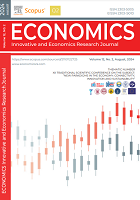DE-DOLLARISATION IN INTERNATIONAL PAYMENTS: TREND OR FICTION
DE-DOLLARISATION IN INTERNATIONAL PAYMENTS: TREND OR FICTION
Author(s): Vesela Todorova, Monika Moraliyska, Iva RaychevaSubject(s): Supranational / Global Economy, Financial Markets, Socio-Economic Research
Published by: Oikos institut-Istraživački centar Bijeljina
Keywords: international payments; foreign exchange; currency; dedollarisation;
Summary/Abstract: The present research paper is focused the widely debated topic related to de-dollarization. It examines the trend of de-dollarization to check if the statements that the dollar is losing its weight and is about to lose its leading position in international trade payments are substantiated. Firstly, the theoretical framework behind the dollarization is explored. Secondly, the factors believed to be the basis of the de-dollarization process have been identified and analyzed, which are related to: geopolitical processes, changes in international payments policy in some BRICS countries, changes in international trade, etc. A performed analysis of the currency turnover in international trade, based on data from official sources, was made through forecast regression, which predicts the development of the share of the dollar in international payments. A correlation matrix was also calculated, showing the correlation links between the dollar and the other leadng currencies. The hypothesis, which is confirmed by the practical research, is that the de-dollarization process is proceeding slowly and uncertainly, and will continue to develop at a low pace leading to insignificant changes in the structure of the currency composition of international payments in the short and medium term. Further research could further explore each of the factors that could lead to a real dedollarisation trend in international payments.
Journal: ECONOMICS-INNOVATIVE AND ECONOMICS RESEARCH JOURNAL
- Issue Year: 12/2024
- Issue No: 2
- Page Range: 129-144
- Page Count: 16
- Language: English

